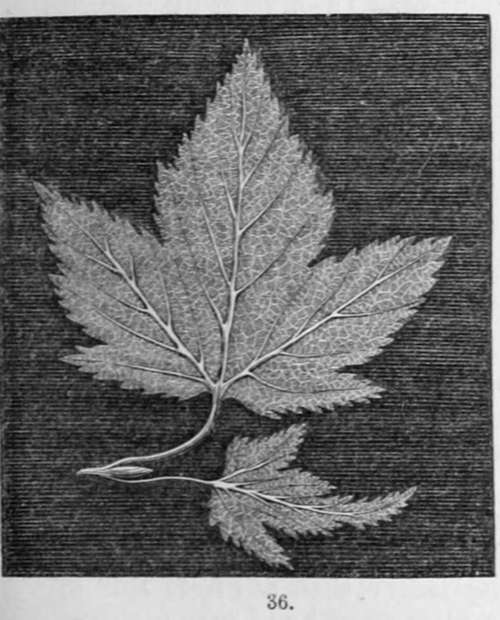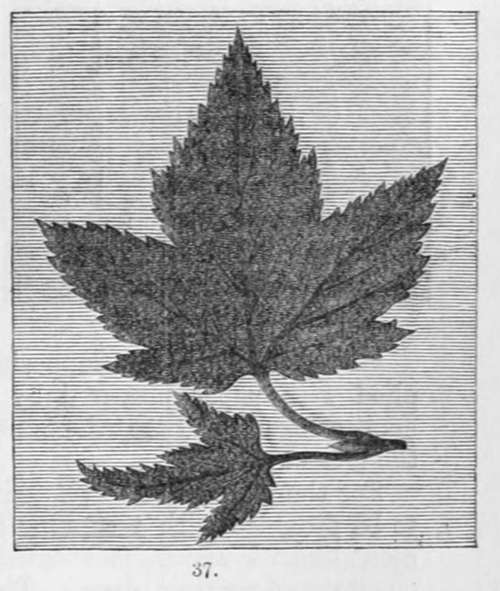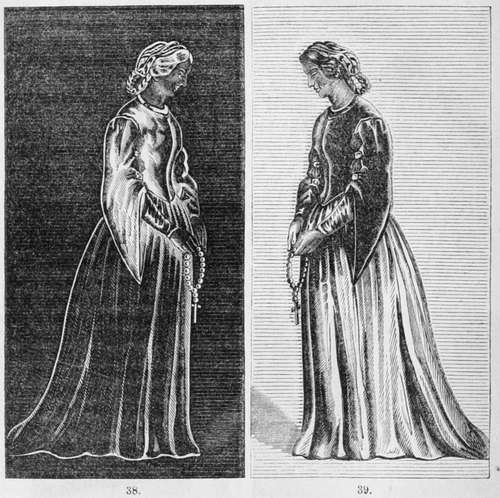Chapter II. On The Apparatus Necessary For The First Practice Of Photography On Paper
Description
This section is from the book "A Manual Of Photography", by Robert Hunt. Also available from Amazon: A Manual of Photography.
Chapter II. On The Apparatus Necessary For The First Practice Of Photography On Paper
The most simple method of obtaining sun-pictures, is that of placing the object to be copied on a sheet of prepared paper, pressing it close by a piece of glass, and exposing the arrangement to sunshine; all the parts exposed darken, while those covered are protected from change, the resulting picture being white upon a dark ground.
It should be here stated, once for all. that such pictures, howsoever obtained, are called negative photographs; and those which have their lights and shadows correct as in natureódark upon a light ground, are positive photographs.
The accompanying woodcut, Fig. 36, represents a negative copy of a currant leaf, and Fig. 37, the positive copy obtained from it.


If a copy is made by means of the camera, of any illuminated object, the picture being produced by the darkening of a white or yellow paper, it will be evident that the highest lights will be represented as dark portions, and the shadows as lights. Thus we obtain a negative image. The female figure in the adjoining woodcut, Fig. 38, is copied from a calotype negative portrait; and this negative being used by superposition on another prepared piece of paper, produces a positive in which the lights and shades are natural, as in the second figure, Fig. 39.

Let us commence by supposing the experimentalist to be supplied with paper prepared by some one acquainted with the manipulation, and that he is now to observe for the first time the effects produced.
For the production of photographic drawings, it is necessary to be provided with a copying frame and glass, the most convenient size for which, is something larger than a single leaf of quarto post writing paper. The glass must be of such a thickness as to resist some considerable pressure, and it should be selected as colourless as possible, great care being taken to avoid such glasses as have a tint of yellow or red, these colours preventing the permeation of a large proportion of the most efficient rays. Figures 40 and 41 represent such a frame in its most simple form ; the first showing it in front, as it is employed in taking a copy of leaves, and the other the back, with its piece of stout tinned iron, or board, which presses on a cushion, securing the close contact of the paper with every part of the object to be copied, and its brass bar, which, when pressed into angular apertures in the sides of the frame, gives the required pressure to the paper. To copy leaves we proceed thus :ó

Having placed the frame face downwards, carefully lay out on the glass, the object to be copied, on which place the photographic paper very smoothly. Then cover this with the cushion, which may be either of flannel or velvet, fix the metal back, and adjust it by the bar, until every part of the object and paper are in the closest contact. For all ordinary uses, this frame answers exceedingly well; but a more convenient pressure frame is constructed in the manner represented by Fig. 42. This contains two bars, one of them movable, and both of them may be fixed in any required position by binding screws.
In arranging botanical specimens, the under surface of the leaves should be next the glass, their upper and smooth surface in contact with the paper. Although very beautiful copies may be taken of dried specimens, they bear no comparison with those from fresh-gathered leaves or recently collected plants, of which, with the most delicate gradations of shades, the veins of the leaves, and the down clothing the stems, are exhibited with incomparable fidelity. In the event of the plant having any thick roots or buds, it will be best to divide them with a sharp knife, for the purpose of equalizing the thickness in all parts, and insuring close contact.

Engravings are to be placed with their faces to the prepared side of the photographic paper, laid very smoothly on the glass, and then with the cushion and back pressed into the closest contact possible: the least difference in the contact, by permitting dispersion, occasions a cloudiness and want of sharpness in the photograph.
Of course a copy of anything taken by means of the rays which have passed through it, must present all the defects as well as all the beauties of the article, whatever it may be. Thus, in copying a print, we have, besides the lines of the engraving, all the imperfections of the paper: This renders it necessary that those engravings should be selected which are on tolerably perfect paper. If the preservation of the engraving is not a matter of much moment, by washing it over the back with a varnish of Canada balsam and spirits of turpentine, it is rendered highly transparent, and the resulting impression is much improved. Care must, however, be taken to use the varnish very thin, that it may not impart any yellow tinge to the paper. An exposure of a few minutes only is sufficient to produce strong and faithful copies during sunshine ; but in diffused daylight a longer period is necessary.
Some kind of copying frame is an indispensable requisite to the photographer: it is used for copying all objects by transmission, and for multiplying the original pictures obtained by means of the camera obscura from nature : it is, indeed, the printing-press of the artist. Some prefer two plates of stout plate-glass pressed very closely together with clamps and screws; but, as the intention is to bring the object to be copied and the sensitive paper into the closest possible contact, numerous mechanical contrivances will suggest themselves for this purpose to the ingenious.
Continue to:
- prev: Selection Of Paper For Photographic Purposes. Part 3
- Table of Contents
- next: On The Apparatus Necessary For The First Practice Of Photography On Paper. Continued
